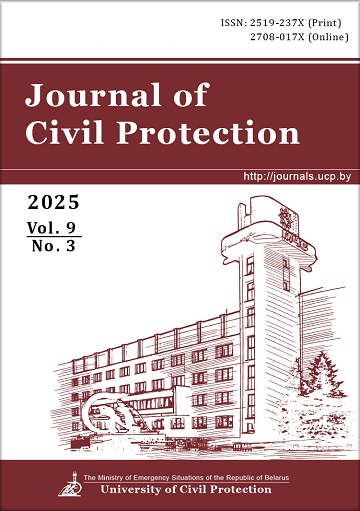Areas of Siberia where in 1979–2024 variations in monthly Precipitation amounts are significantly associated with changes in the state of El Niño–the Southern Oscillation anticipatory of these amounts
DOI:
https://doi.org/10.33408/2519-237X.2025.9-3.359Keywords:
Siberia, monthly precipitation, El Niño – Southern Oscillation, fire hazard according to weather conditionsAbstract
Purpose. Interannual changes in monthly amounts of atmospheric precipitation falling in any territory during the fire-hazardous season and in the months preceding it are significant factors of fire hazard based on weather conditions. Therefore, identifying processes in the climate system of our planet that significantly influence this process in the territories of the regions of Russia located in Siberia is a pressing problem of climatology and safety in emergency situations. One of such processes may be El Niño – Southern Oscillation. The state of this process is usually characterized by a number of global climate indices, among which the most informative is Nino 3-4.
Methods. To test the hypothesis of the work, a method based on correlation analysis of the connections between the processes under consideration was used. When assessing the significance of the identified connections, the Student criterion was used.
Findings. A hypothesis has been put forward about the existence of areas in Siberia where changes in monthly precipitation amounts in certain months are significantly associated with variations in the Nino 3-4 index, which precede it in time. The obtained results show that for all months from March to October, as well as for December, the studied relationships are significant for many areas of the territory of Siberia, if the changes in the index under consideration are ahead of the variations in the monthly amounts of atmospheric precipitation falling on them by 1 and 2 months. The total area of such areas located in the south of Siberia, as well as in Kazakhstan, China and Mongolia, is maximum in December. Similar areas have been identified in the territories related to the Taiga landscape zone. The latter indicates that the influence of the El Niño – Southern Oscillation process on the dynamics of fire danger by weather conditions in such areas is significant.
Application field of research. The obtained results indicate the possibility of their practical application in modelling and forecasting of changes in fire danger under weather conditions on the territories of many regions of Siberia.
References
Kobysheva N.V., Akent'eva E.M., Bogdanova E.G. [et al.]. Klimat Rossii [Climate of Russia]. Saint Petersburg: Gidrometeoizdat, 2001. 654 p. (rus)
Valendik E.N., Kisilyakhov E.K., Ryzhkova V.A., Ponomarev E.I., Danilova I.V. Landshaftnye pozhary taygi Tsentral'noy Sibiri [Landscape fires in the taiga of Central Siberian]. Izvestiya Rossiiskoi Akademii Nauk. Seriya Geograficheskaya, 2014. No. 3. Pp. 73–86. (rus). EDN: https://elibrary.ru/SGFQDL.
Vorob'ev Yu.L., Akimov V.A., Sokolov Yu.I. Lesnye pozhary na territorii Rossii: Sostoyanie i problemy [Forest fires in Russia: Status and problems]. Moscow: DEKS-PRESS, 2004. 312 p. (rus)
Mozyrev N.K., Kornishin V.A., Koshkarov V.S. Pozharnaya bezopasnost' lesov [Fire safety of forests]. Vestnik sovremennykh issledovaniy, 2019. No. 2-1 (29). Pp. 60–63. (rus). EDN: https://elibrary.ru/PPGJEZ.
Ivanova G.A., Ivanov V.A., Musokhranova A.V., Onuchin A.A. Lesnye pozhary i prichiny ikh vozniknoveniya na territorii sredney Sibiri [Forest fires and the causes of their occurence in Central Siberia]. Siberian Journal of Forest Science, 2023. No. 6. Pp. 6–16. (rus). DOI: https://doi.org/10.15372/SJFS20230602. EDN: https://elibrary.ru/WLJIIC.
Informatsionnaya sistema distantsionnogo monitoringa Federal'nogo agentstva lesnogo khozyaystva [Remote Monitoring Information System of the Federal Forestry Agency]: official website. Moscow. URL: https://pushkino.aviales.ru/main_pages/index.shtml (accessed: March 10, 2025). (rus)
Gosudarstvennyy doklad «O sostoyanii zashchity naseleniya i territoriy Rossiyskoy Federatsii ot chrezvychaynykh situatsiy prirodnogo i tekhnogennogo kharaktera v 2022 godu» [State report «On the state of protection of the population and territories of the Russian Federation from natural and man-made emergencies in 2022»]. Ministry of the Russian Federation for Civil Defense, Emergencies and Elimination of Consequences of Natural Disasters. Moscow, 2023. 461 p. (rus)
Walker G.T. Correlation in seasonal variations of weather. IX. A further study of world weather. Memoirs of the Indian Meteorological Department, 1924. Vol. 24. P. 275–332.
Stewart R. El Niño and Tropical Heat. Our Ocean Planet: Oceanography in the 21st Century. Department of Oceanography, Texas A&M University, 2009.
Petrosyants M.A., Semenov E.K., Gushchina D.Yu., Sokolikhina E.V., Sokolikhina N.N. Tsirkulyatsiya atmosfery v tropikakh: klimat i izmenchivost' [Atmospheric circulation in the tropics: climate and variability]. Moscow: Maks Press. 2005. 670 p. (rus)
Mokhov I.I., Timazhev A.V. Climatic anomalies in Eurasia from of El Niño/La Niña effects. Doklady Earth Sciences, 2013. Vol. 453, No. 1. Pp. 1141–1144. DOI: https://doi.org/10.1134/S1028334X13110123. EDN: https://elibrary.ru/SLLWBV.
Petrosyants M.A., Gushchina D.Yu. Definition of El Niño and La Niña events. Russian Meteorology and Hydrology, 2002. No. 8. Pp. 16–24. EDN: https://elibrary.ru/LHLEVZ.
El Niño Southern Oscillation (ENSO). World Health Organization: official website. November 9, 2023. URL: https://www.who.int/news-room/fact-sheets/detail/el-nino-southern-oscillation-(enso) (accessed: March 10, 2025).
Gushchina D., Kolennikova M., Dewitte B., Yeh S.-W. On the relationship between ENSO diversity and the ENSO atmospheric teleconnection to high-latitudes. International Journal of Climatology, 2022. Vol. 42, No. 2. Pp. 1303–1325. DOI: https://doi.org/10.1002/joc.7304.
Dzerdzeevskiy B.L. Tsirkulyatsionnye mekhanizmy v atmosfere Severnogo polushariya v XX stoletii [Circulation mechanisms in the atmosphere of the Northern Hemisphere in the 20th century]. Moscow, 1968. 240 p. (rus)
Hsiang S.M., Meng K.C., Cane M.A. Civil conflicts are associated with the global climate. Nature, 2011. Vol. 476. Pp. 438–441. DOI: https://doi.org/10.1038/nature10311.
Mokhov I.I., Akperov M.G., Prokofyeva M.A., Timazhev A.V., Lupo A.R., Le Treut H. Blockings in the Northern hemisphere and Euro-Atlantic region: Estimates of changes from reanalysis data and model simulations. Doklady Earth Sciences, 2013. Vol. 449, No. 2. Pp. 430–433. DOI: https://doi.org/10.1134/S1028334X13040144. EDN: https://elibrary.ru/RFFCWD.
Shakina N.P., Ivanova A.R. The blocking anticyclones: the state of studies and forecasting. Russian Meteorology and Hydrology, 2010. Vol. 35, No. 11. Pp. 721–730. DOI: https://doi.org/10.3103/S1068373910110014. EDN: https://elibrary.ru/OBAWGV.
Kholoptsev A.V., Semenov V.A., Kononova N.K. Prodolzhitel'nye Arkticheskie vtorzheniya i El'-Nin'o – Yuzhnoe kolebanie [Long Arctic invasion and El-Nino – Southern Oscillation]. Izvestiya Rossiiskoi Akademii Nauk. Seriya Geograficheskaya, 2018. No. 4. Pp. 22–32. (rus). DOI: https://doi.org/10.1134/S2587556618040088. EDN: https://elibrary.ru/XXYWCL.
Polonskiy A.B. Rol' okeana v izmeneniyakh klimata [The role of the ocean in climate change]. Kiev: Naukova dumka, 2008. 182 p. (rus)
Nesterov E.S. Variability of atmospheric and oceanic characteristics in the European Atlantic region in the El Niño and La Niña years events. Russian Meteorology and Hydrology, 2000. No. 8. Pp. 43–50. EDN: https://elibrary.ru/LGJMND.
Gruza G.V., Ran'kova E.Ya., Kleshchenko L.K., Aristova L.N. O svyazi klimaticheskikh anomaliy na territorii Rossii s yavleniem El'-Nin'o – Yuzhnoe kolebanie [On the connection of climatic anomalies in Russia with the phenomenon of El Niño – Southern oscillation]. Meteorologiya i gidrologiya, 1999. No. 5. Pp. 32–51. (rus)
Hoffmann L., Günther G., Li D., Stein O., Wu X., Griessbach S., Heng Y., Konopka P., Müller R., Vogel B., Wright J.S. From ERA-Interim to ERA5: the considerable impact of ECMWF’s next-generation reanalysis on Lagrangian transport simulations. Atmospheric Chemistry and Physics, 2019. Vol. 19, No. 5. Pp. 3097–3124. DOI: https://doi.org/10.5194/acp-19-3097-2019.
ERA5 hourly data on pressure levels from 1940 to present: [database]. Copernicus Climate Change Service, Climate Data Store, 2023. URL: https://cds.climate.copernicus.eu/cdsapp#!/dataset/reanalysis-era5-pressure-levels?tab=form (accessed: March 10, 2025). DOI: https://doi.org/10.24381/cds.bd0915c6.
Global climate data: [database]. Weather: website TuTiempo.net. URL: https://en.tutiempo.net/climate (accessed: March 10, 2025).
Zacks Sh. Teoriya statisticheskikh vyvodov [The theory of statistical inference]: translation from English. Moscow: Mir, 1975. 776 p. (rus)
Published
How to Cite
License
Copyright (c) 2025 Kholoptsev A.V., Shubkin R.G., Koval Y.N.

This work is licensed under a Creative Commons Attribution-NonCommercial 4.0 International License.




















